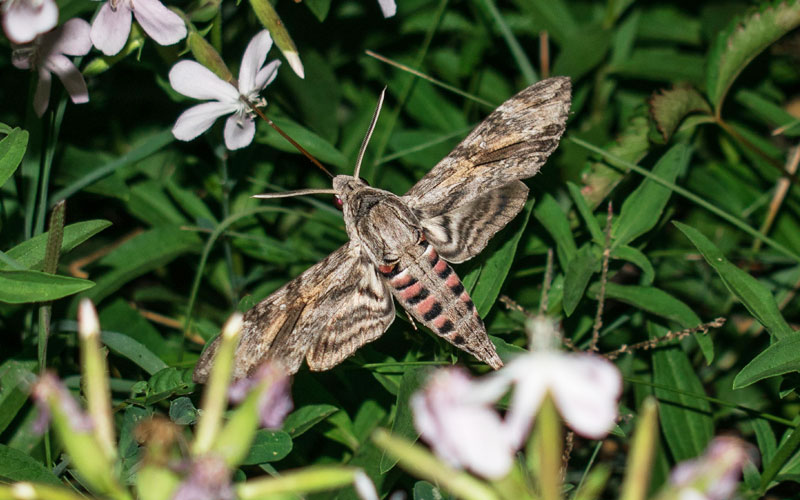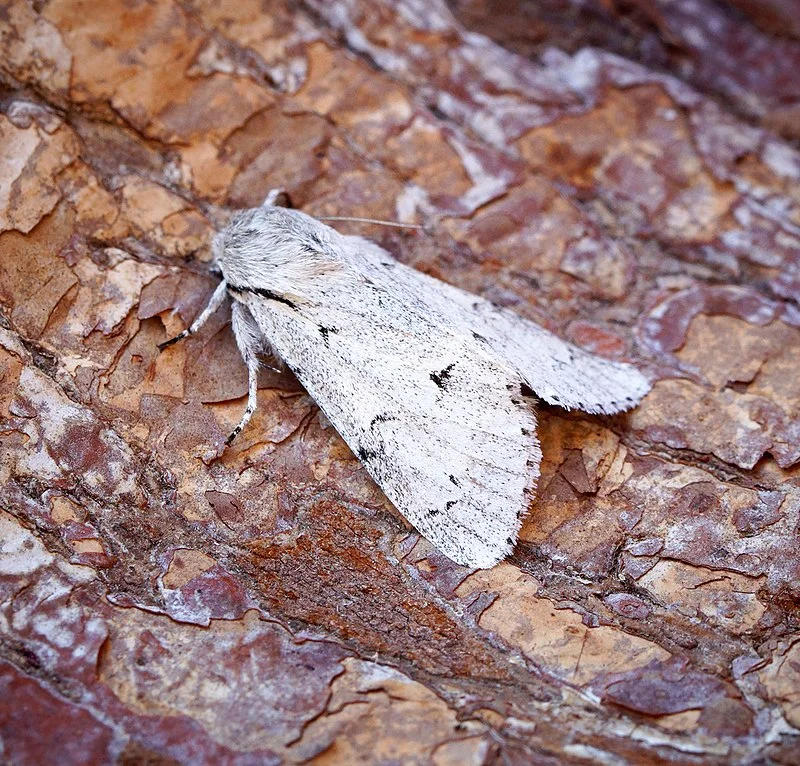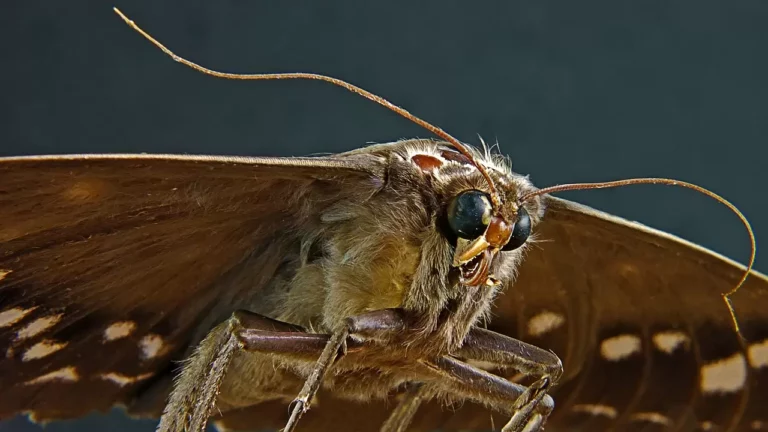Moths are generally not known for making noise in the same way that some other insects, like crickets or cicadas, do. They are typically silent fliers and do not produce audible sounds through vocalizations or other means.
However, there are some exceptions to this general rule. Some species of moths are capable of producing faint, high-pitched sounds that are often not audible to the human ear. These sounds are usually used for communication between moths, particularly during mating.
The sounds are produced by specialized structures on their bodies, such as stridulatory organs or wing movements, which create vibrations that can be detected by other moths.
How are moths different from other insects?

While moths are generally not known for their sound production, sound plays a vital role in the broader insect world, influencing communication, predation, and ecological interactions among various species.
General characteristics of moths:
Taxonomy and diversity: Moths belong to the order Lepidoptera, which also includes butterflies. There are over 160,000 known species of moths, making them a highly diverse group.
Morphology: Moths typically have stout bodies covered in scales that give them their characteristic wing patterns and colors. Moreover, their antennae are often feathery or filamentous, in contrast to the clubbed antennae of butterflies.
Nocturnal behavior: Many moths are primarily active during the night, exhibiting nocturnal behavior. Nocturnality is an adaptation that helps them avoid daytime predators and conserve energy.
Feeding habits: Moths exhibit a wide range of feeding habits, including herbivory, nectar-feeding, and some species are even carnivorous in their larval stage. The caterpillar stage of moths is typically associated with voracious feeding.
Differences between moths and other insects
Here’s the differences between moths and butterflies based on the provided information:
| Characteristic | Moths | Butterflies |
| Wings and Flight | Broader, elongated wings | Colorful, slender wings (diurnal flight) |
| Antennae | Feathery or filamentous antennae | Clubbed or knobbed antennae |
| Resting Posture | Wings held flat against the body | Wings held upright and together at rest |
| Coloration | Earth-toned or cryptic coloration | Brightly colored, some with warning colors |
The importance of sound in the insect world:
Communication and mating: Sound plays a crucial role in insect communication, especially for species that are nocturnal or live in environments with limited visibility.
Insects, including moths, use sounds to locate potential mates and establish their presence.
Predation and defense: Some insects produce sounds as a defense mechanism against predators. For example, some moths can produce ultrasonic sounds to deter echolocating bats, which are their primary nocturnal predators.
Ecological interactions: Insect sounds can have cascading effects on ecosystems by influencing the behavior of other species.
For instance, the sounds produced by crickets and katydids serve as important cues for predators, such as birds, in locating prey.
Species diversity: Sound production is a trait that contributes to the diversity of insect species, allowing them to occupy various ecological niches.
Different insect species have evolved unique sound-producing mechanisms and frequencies to avoid competition for resources.
How do moths communicate?
Insects have evolved a wide array of communication mechanisms to convey information to other individuals of their species or different species. Communication is essential for various purposes, including mating, establishing territory, warning of danger, and coordinating group activities. Insects use several sensory channels for communication, including visual, chemical, tactile, and auditory cues.
Communication methods used by moths:
Moths, like many other insects, employ multiple communication strategies to interact with conspecifics (members of the same species) and facilitate various aspects of their life cycle. These methods include:
| Communication Method | Description |
| Stridulation | Production of sound by rubbing body parts; less common in moths; structures involved vary among species; used for attracting mates or deterring predators. |
| Wing Movements | Visual communication through wing movements; includes specific flight patterns and fluttering; often associated with courtship rituals; helps moths identify suitable mates. |
| Pheromones | Chemical substances released for communication; crucial in moth mating; females release sex pheromones; males have sensitive antennae to detect and locate females. |
The role of communication in moth mating:
Communication is paramount in moth mating because most moth species are nocturnal and have limited visual interactions. Here’s how communication contributes to their reproductive success:
Mate attraction: Male moths use various communication methods, such as pheromone detection and visual displays, to locate and attract females. Pheromones, in particular, are highly species-specific and aid in mate recognition.
Courtship rituals: Once a male finds a female, courtship rituals involve a series of behavioral displays, including wing movements and contact behaviors, to ensure that both individuals are of the same species and receptive to mating.
Pheromone signaling: Female moths release pheromones at specific times in their reproductive cycle, signaling to males when they are ready to mate. This precise timing reduces energy expenditure and increases mating success.
Avoiding hybridization: The use of species-specific pheromones helps prevent hybridization between different moth species, maintaining the integrity of each species.
Predator avoidance: In some cases, the sounds produced by stridulation or the visual displays during courtship may deter potential predators, enhancing the survival chances of the mating pair.
How do moths fly silently?
Moths have developed several remarkable adaptations that allow them to fly silently, a feature that is essential for their survival as nocturnal creatures.
Specialized wing morphology: The leading edges of moth wings have a comb-like structure known as “scales.” These scales break up the turbulent airflow that typically generates sound during flight. By reducing turbulence, moths minimize the production of aerodynamic noise.
Slower wingbeat frequency: Moths generally have a slower wingbeat frequency compared to diurnal insects like bees or flies. Slower wingbeats generate less sound. This reduced wingbeat frequency is partially a result of their nocturnal lifestyle, where speed and maneuverability are less critical.
Flexible wing joints: Moth wings have specialized joints that allow for greater flexibility and control during flight. This flexibility helps reduce vibrations that can produce sound.
Adaptations for silent flight
Moths have evolved various structural and behavioral adaptations to enhance their ability to fly silently, which is crucial for avoiding detection by predators and prey:
Serrated wing edges: The jagged or serrated edges of moth wings further disrupt the airflow, reducing noise production. These serrations help break up the vortex of air that typically generates sound.
Preening behavior: Some moth species engage in preening behaviors, using their legs to groom their wings. This grooming helps maintain the integrity of wing scales and reduces the chances of sound-producing friction during flight.
Elastic wing veins: The veins of moth wings contain elastic materials that can absorb and dissipate energy generated during wing flapping. This elasticity reduces the transmission of vibrations through the wings, contributing to silent flight.
Low aspect ratio: Moth wings often have a low aspect ratio, meaning they are relatively broad compared to their length. This wing shape enhances lift and stability, allowing moths to fly silently while efficiently gliding through the air.
Camouflage and cryptic coloration: In addition to their wing adaptations, moths often have cryptic coloration and patterns that help them blend into their surroundings, reducing the likelihood of visual detection by predators.
Comparison with other insects that produce audible sounds
Moths’ ability to fly silently stands in contrast to many other insects, particularly those that produce audible sounds during flight, such as bees, flies, and some beetles. The primary differences lie in their wing morphology, flight behavior, and ecological roles:
Wing morphology: Insects that produce audible sounds often have wings that are optimized for maneuverability and speed.
These wings generate more turbulence, resulting in the production of sound. In contrast, moths’ wing structures are adapted to reduce turbulence and minimize noise.
Flight behavior: Diurnal insects like bees and flies are often more active during the day when visibility is better.
Their flight patterns and speed are optimized for daylight conditions, where silent flight may be less critical. Moths, being nocturnal, have evolved to rely on stealth and silence to evade nocturnal predators.
Ecological roles: Insects that produce audible sounds during flight may use these sounds for communication, navigation, or territorial defense.
For example, male mosquitoes produce a high-pitched whine to attract females, while bees communicate with their hive mates through various buzzing sounds. In contrast, moths primarily use pheromones and other non-auditory cues for communication.
Which moths make audible sounds?

While most moths are known for their silent flight, there are exceptions among moth species that are capable of producing audible sounds. Notable examples include:
Luna Moth (Actias luna): Luna moth caterpillars can produce hissing or clicking sounds by expelling air through their spiracles (tiny openings on their bodies). This sound is used as a defensive mechanism to deter predators.
Death’s-Head Hawkmoth (Acherontia spp.): Some species in the Acherontia genus are known for producing clicking or squeaking sounds as adults by rubbing their proboscises against their abdomens. This behavior is thought to be a form of communication.
Tiger Moths (Arctiidae family): Tiger moths are known for producing ultrasonic sounds that are used in communication. These sounds are often associated with mate attraction and predator deterrence.
How do researchers study moth sounds with limited human hearing?
Human hearing has limitations, particularly in the context of detecting moth sounds:
Frequency range: Moth sounds, especially ultrasonic ones, often fall outside the typical range of human hearing, which is generally limited to frequencies between 20 Hz and 20,000 Hz.
Sound amplitude: Moth sounds may be very faint and easily masked by ambient noise, making them difficult for humans to perceive without specialized equipment.
Selective hearing: Humans may not naturally tune into sounds produced by moths because they are not relevant to our survival or communication.
The challenges in detecting moth sounds
Detecting and studying moth sounds present several challenges:
Equipment: Specialized equipment, such as ultrasonic microphones or bat detectors, is often required to capture and analyze moth sounds.
Background noise: Urban and natural environments can be noisy, making it challenging to isolate and identify moth sounds amid other environmental sounds.
Variability: Moth sounds can vary widely between species, making it necessary to have a broad understanding of moth biology and acoustics to correctly identify and interpret the sounds.
Tools and technologies used for studying moth sounds:
Researchers use a range of tools and technologies to study moth sounds:
Ultrasonic microphones: These specialized microphones are designed to capture ultrasonic sounds, enabling researchers to record and analyze moth sounds that fall outside the range of human hearing.
Bat detectors: While primarily used to study bats, bat detectors can also capture the ultrasonic sounds produced by moths, particularly during predator-prey interactions.
Acoustic analysis software: Researchers use software programs to analyze recorded sounds, identify species-specific patterns, and gain insights into the function and significance of moth sounds.
Field recordings: Fieldwork involving the deployment of recording equipment in moth habitats is crucial for studying moth sounds in their natural environment.
FAQ’s
Do moths squeak?
No, most moths do not squeak. They are generally silent fliers and communicate using other methods like pheromones or wing movements.
Are moths quiet?
Yes, in general, moths are quiet. Their flight is adapted for silent movement to avoid predators.
What insect makes clicking noise at night?
Some insects that make clicking noises at night include certain types of beetles, like the “click beetle,” which produces a distinctive clicking sound as part of its defensive behavior.
Why are moths so quiet?
Moths have evolved to fly silently to avoid detection by predators. Their wing structures and movements are adapted to minimize sound production during flight.
Why are moths so noisy?
While most moths are quiet, some species can produce noise through stridulation or other mechanisms. This noise may serve purposes like communication or defense.
Which moth squeaks?
Certain moth species, like the Death’s-Head Hawkmoth, can produce clicking or squeaking sounds, often associated with communication or territorial behavior.
Is it OK to hold a moth?
It’s generally safe to hold a moth gently if necessary, but it’s important to handle them with care to avoid damaging their delicate wings or other body parts.
Conclusion
In summary, moths are fascinating creatures with a wide range of traits and behaviors. Most moths fly silently and have clever ways to communicate, but there are some moths that can make noise.
When it comes to hearing moth sounds, people have limitations, so scientists use special tools to study these sounds. Moths are truly remarkable insects with complex biology and interesting ways of communicating, making them a captivating subject of study for scientists and nature enthusiasts, highlighting the amazing diversity found in the insect world.

